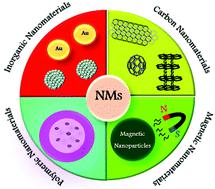当前位置:
X-MOL 学术
›
Biomater. Sci.
›
论文详情
Our official English website, www.x-mol.net, welcomes your feedback! (Note: you will need to create a separate account there.)
Nanomaterial based drug delivery systems for the treatment of neurodegenerative diseases.
Biomaterials Science ( IF 6.6 ) Pub Date : 2020-06-22 , DOI: 10.1039/d0bm00809e Shima Masoudi Asil 1 , Jyoti Ahlawat , Gileydis Guillama Barroso , Mahesh Narayan
Biomaterials Science ( IF 6.6 ) Pub Date : 2020-06-22 , DOI: 10.1039/d0bm00809e Shima Masoudi Asil 1 , Jyoti Ahlawat , Gileydis Guillama Barroso , Mahesh Narayan
Affiliation

|
With an aging population that has been increasing in recent years, the need for the development of therapeutic approaches for treatment of neurodegenerative disorders (ND) has increased. ND, which are characterized by the progressive loss of the structure or function of neurons, are often associated with neuronal death. In spite of screening numerous drugs, currently there is no specific treatment that can cure these diseases or slow down their progression. Alzheimer's disease (AD), Parkinson's disease (PD), amyotrophic lateral sclerosis (ALS), frontotemporal dementia, Huntington's disease, and prion diseases belong to ND which affect enormous numbers of people globally. There are some main possible reasons for failure in the treatment of neurodegenerative diseases such as limitations introduced by the Blood–Brain Barrier (BBB), the Blood–Cerebrospinal Fluid Barrier (BCFB) and P-glycoproteins. Current advances in nanotechnology present opportunities to overcome the mentioned limitations by using nanotechnology and designing nanomaterials improving the delivery of active drug candidates. Some of the basic and developing strategies to overcome drug delivery impediments are the local delivery of drugs, receptor-mediated transcytosis, physicochemical disruption of the BBB, cell-penetrating peptides and magnetic disruption. Recently, the application of nanoparticles has been developed to improve the efficiency of drug delivery. Nanoengineered particles as nanodrugs possess the capacity to cross the BBB and also show decreased invasiveness. Examples include inorganic, magnetic, polymeric and carbonic nanoparticles that have been developed to improve drug delivery efficiency. Despite numerous papers published in this filed, there are some unsolved issues that need to be addressed for successful treatment of neurodegenerative diseases. These are discussed herein.
中文翻译:

基于纳米材料的药物输送系统用于治疗神经退行性疾病。
近年来,随着人口老龄化的不断增加,开发治疗神经退行性疾病(ND)的治疗方法的需求也随之增加。ND 的特征是神经元结构或功能进行性丧失,通常与神经元死亡相关。尽管筛选了许多药物,但目前还没有特定的治疗方法可以治愈这些疾病或减缓其进展。阿尔茨海默病 (AD)、帕金森病 (PD)、肌萎缩侧索硬化症 (ALS)、额颞叶痴呆、亨廷顿病和朊病毒病都属于 ND,影响着全球大量人口。神经退行性疾病治疗失败的主要原因有一些,例如血脑屏障 (BBB)、血脑脊液屏障 (BCFB) 和 P-糖蛋白造成的限制。当前纳米技术的进步为通过使用纳米技术和设计纳米材料来克服上述限制提供了机会,以改善活性候选药物的输送。克服药物递送障碍的一些基本和正在开发的策略是药物的局部递送、受体介导的转胞吞作用、BBB的物理化学破坏、细胞穿透肽和磁破坏。最近,纳米颗粒的应用已被开发来提高药物输送的效率。纳米工程颗粒作为纳米药物具有穿过血脑屏障的能力,并且还表现出降低的侵袭性。例子包括为提高药物输送效率而开发的无机、磁性、聚合物和碳纳米颗粒。尽管该领域发表了大量论文,但为了成功治疗神经退行性疾病,仍有一些未解决的问题需要解决。这些将在本文中讨论。
更新日期:2020-07-28
中文翻译:

基于纳米材料的药物输送系统用于治疗神经退行性疾病。
近年来,随着人口老龄化的不断增加,开发治疗神经退行性疾病(ND)的治疗方法的需求也随之增加。ND 的特征是神经元结构或功能进行性丧失,通常与神经元死亡相关。尽管筛选了许多药物,但目前还没有特定的治疗方法可以治愈这些疾病或减缓其进展。阿尔茨海默病 (AD)、帕金森病 (PD)、肌萎缩侧索硬化症 (ALS)、额颞叶痴呆、亨廷顿病和朊病毒病都属于 ND,影响着全球大量人口。神经退行性疾病治疗失败的主要原因有一些,例如血脑屏障 (BBB)、血脑脊液屏障 (BCFB) 和 P-糖蛋白造成的限制。当前纳米技术的进步为通过使用纳米技术和设计纳米材料来克服上述限制提供了机会,以改善活性候选药物的输送。克服药物递送障碍的一些基本和正在开发的策略是药物的局部递送、受体介导的转胞吞作用、BBB的物理化学破坏、细胞穿透肽和磁破坏。最近,纳米颗粒的应用已被开发来提高药物输送的效率。纳米工程颗粒作为纳米药物具有穿过血脑屏障的能力,并且还表现出降低的侵袭性。例子包括为提高药物输送效率而开发的无机、磁性、聚合物和碳纳米颗粒。尽管该领域发表了大量论文,但为了成功治疗神经退行性疾病,仍有一些未解决的问题需要解决。这些将在本文中讨论。



























 京公网安备 11010802027423号
京公网安备 11010802027423号